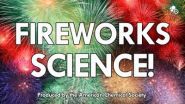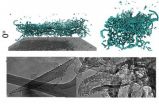(Press-News.org) WASHINGTON, June 30, 2014 — The Fourth of July is just days away, and that means millions of Americans will soon enjoy eye-popping fireworks displays around the country. These dazzling light shows are actually carefully crafted chemical reactions. This week's Reactions episode features John Conkling, Ph.D., the professor who literally wrote the book on pyrotechnics. In the video, Conkling explains the chemistry that creates those amazing fireworks displays. The video is available at http://www.youtube.com/watch?v=nPHegSulI_M.
Subscribe to the series at Reactions YouTube, and follow us on Twitter @ACSreactions to be the first to see our latest videos.
The American Chemical Society is a nonprofit organization chartered by the U.S. Congress. With more than 161,000 members, ACS is the world's largest scientific society and a global leader in providing access to chemistry-related research through its multiple databases, peer-reviewed journals and scientific conferences. Its main offices are in Washington, D.C., and Columbus, Ohio.
INFORMATION:
To automatically receive news releases from the American Chemical Society, contact newsroom@acs.org.
Follow us: Twitter Facebook
The chemistry of fireworks: Fourth of July science (video)
2014-06-30
ELSE PRESS RELEASES FROM THIS DATE:
Study finds low hand hygiene compliance rates during anesthesia administration
2014-06-30
Washington, DC, June 30, 2014 – Anesthesia providers are missing opportunities to clean their hands during surgical procedures, according to a study published in the July issue of the American Journal of Infection Control, the official publication of the Association for Professionals in Infection Control and Epidemiology (APIC).
In the study, researchers at Dartmouth-Hitchcock Medical Center used video observation to map patterns of anesthesia provider hand contact with anesthesia work environment surfaces to assess hand hygiene compliance. Researchers observed an average ...
Forelimb bone data predicts predator style
2014-06-30
At the start of their research, paleobiologists Christine Janis and Borja Figueirido simply wanted to determine the hunting style of an extinct marsupial called Thylacine (also known as the "marsupial wolf" or the "Tasmanian tiger"). In the end, the Australian relic, which has a very dog-like head but with both cat- and dog-like features in the skeleton, proved to be uniquely unspecialized, but what emerged from the effort is a new classification system that can capably predict the hunting behaviors of mammals from measurements of just a few forelimb bones.
"We realized ...
A key component of cell division comes to light
2014-06-30
VIDEO:
This is a video of the study about the dynamics of microtubule minus ends in the human mitotic spindle.
Click here for more information.
The division of a cell in two requires the assembly of the mitotic spindle, an extremely complex structure, which is the result of the coordinated action of a multitude of proteins and a finely tuned balance of their activities. A large part of the time that a cell requires to divide is devoted to assembling the mitotic spindle, which, ...
Study: Four Habits Model prepares pediatric nurses for emotionally difficult discussions
2014-06-30
INDIANAPOLIS -- A child's illness and hospitalization are extremely stressful for both the child and the parents. A new study reports that the Four Habits Model of Highly Effective Clinicians, a core set of communication skills developed to help physicians communicate with patients, can successfully prepare inexperienced nurses for emotionally difficult conversations with parents of pediatric patients.
The evidence-based Four Habits Model was co-developed 20 years ago by Regenstrief Institute investigator Richard Frankel, Ph.D., a sociologist and medical educator whose ...
Potential drug target for PTSD prevention
2014-06-30
Scientists at Yerkes National Primate Research Center, Emory University have identified a drug that appears to make memories of fearsome events less durable in mice.
The finding may accelerate the development of treatments for preventing PTSD (post-traumatic stress disorder). The drug, called osanetant, targets a distinct group of brain cells in a region of the brain that controls the formation and consolidation of fear memories.
The results were published in the journal Neuron.
"Potentially, drugs that act on this group of cells could be used to block fear memory ...
Green planning needed to maintain city buildings
2014-06-30
Green spaces in towns and cities need extra consideration as they may be damaging buildings in the area, according to new research from the Universities of Southampton and Surrey.
When organic chemicals from trees and vegetation mix with air pollutants the resulting corrosive gas can increase the erosion of building materials, including stone, concrete and steel.
Southampton's Dr Abhishek Tiwary, who is based within the Centre for Environmental Sciences, and Dr Prashant Kumar, from the University of Surrey, found that heritage buildings, built from limestone and sandstone, ...
Interlayer distance in graphite oxide gradually changes when water is added
2014-06-30
Physicists from Umeå University and Humboldt University in Berlin have solved a mystery that has puzzled scientists for half a century. They show with the help of powerful microscopes that the distance between graphite oxide layers gradually increases when water molecules are added. That is because the surface of graphite oxide is not flat, but varies in thickness with "hills" and "valleys" of nanosize. The new findings are published in the scientific journal Nano Letters.
"Now we can better understand the mechanisms of solvent insertion between layers of graphene oxide. ...
Researchers unzip nanotubes by shooting them at 15,000 mph
2014-06-30
Carbon nanotubes "unzipped" into graphene nanoribbons by a chemical process invented at Rice University are finding use in all kinds of projects, but Rice scientists have now found a chemical-free way to unzip them.
The Rice lab of materials scientist Pulickel Ajayan discovered that nanotubes that hit a target end first turn into mostly ragged clumps of atoms. But nanotubes that happen to broadside the target unzip into handy ribbons that can be used in composite materials for strength and applications that take advantage of their desirable electrical properties.
The ...
Stem cells may be more widespread and with greater potential than previously believed
2014-06-30
With the plethora of research and published studies on stem cells over the last decade, many would say that the definition of stem cells is well established and commonly agreed upon. However, a new review article appearing in the July 2014 issue of The FASEB Journal , suggests that scientists have only scratched the surface of understanding the nature, physiology and location of these cells. Specifically, the report suggests that embryonic and induced pluripotent stem cells may not be the only source from which all three germ layers in the human body (nerves, liver or ...
Bosses use private social media more than staff
2014-06-30
The research shows that managers hold more negative attitudes to private use of social media at work than subordinates. About 11,000 Norwegian employees participated in the researchers' study Predictors of Use of Social Network Sites at Work.
"It is very interesting that top executives, who are negative to private web-surfing during working hours, are the ones who surf the most for private purposes when at work," says Doctor Cecilie Schou Andreassen at UiB's Department of Psychosocial Science.
She suggests that this can be explained by the fact that top executives have ...





